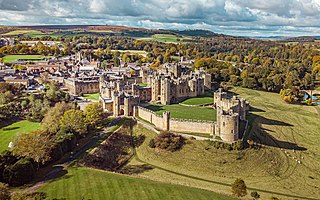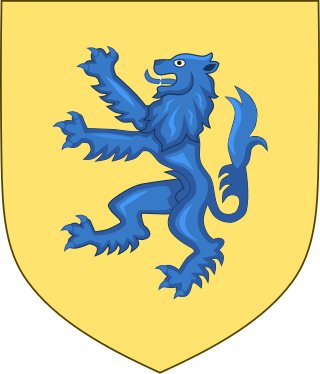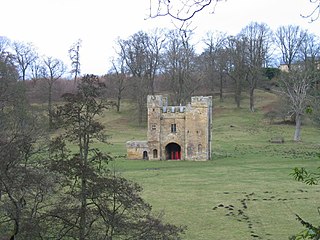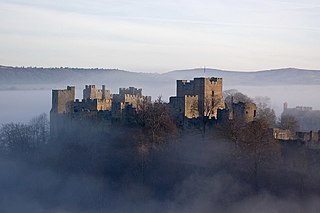Related Research Articles

Alnwick Castle is a castle and country house in Alnwick in the English county of Northumberland. It is the seat of the 12th Duke of Northumberland, built following the Norman conquest and renovated and remodelled a number of times. It is a Grade I listed building now the home of Ralph Percy, 12th Duke of Northumberland and his family. In 2016, the castle received over 600,000 visitors per year when combined with adjacent attraction the Alnwick Garden.

Henry de Bohun, 1st Earl of Hereford of Pleshey Castle in Essex, was an Anglo-Norman nobleman who became Hereditary Constable of England from 1199.

The title of Earl of Northumberland has been created several times in the Peerage of England and of Great Britain, succeeding the title Earl of Northumbria. Its most famous holders are the House of Percy, who were the most powerful noble family in Northern England for much of the Middle Ages. The heirs of the Percys, via a female line, were ultimately made Duke of Northumberland in 1766, and continue to hold the earldom as a subsidiary title.

The Percy family is an ancient English noble family. They were among the oldest and most powerful noble families in Northern England for much of the Middle Ages. The noble family is known for its long rivalry with the House of Neville, another family powerful in northern England during the 15th century. The feud between the two families, known as the Percy-Neville feud led to the Wars of the Roses, at the time known as the Civil Wars, in England.

de Lacy is the surname of an old Norman family which originated from Lassy, Calvados. The family took part in the Norman Conquest of England and the later Norman invasion of Ireland. The name is first recorded for Hugh de Lacy (1020–1085). His sons, Walter and Ilbert, left Normandy and travelled to England with William the Conqueror. The awards of land by the Conqueror to the de Lacy sons led to two distinct branches of the family: the northern branch, centred on Blackburnshire and west Yorkshire was held by Ilbert's descendants; the southern branch of Marcher Lords, centred on Herefordshire and Shropshire, was held by Walter's descendants.

The Barony of Halton, in Cheshire, England, comprised a succession of 15 barons and hereditary Constables of Chester under the overlordship of the Earl of Chester. It was not an English feudal barony granted by the king but a separate class of barony within the County Palatine of Chester.

Alnwick Abbey was founded as a Premonstratensian monastery in 1147 by Eustace fitz John near Alnwick, England, as a daughter house of Newhouse Abbey in Lincolnshire. It was dissolved in 1535, refounded in 1536 and finally suppressed in 1539. The Alnwick Abbey site is located just within Hulne Park, on the bank of the River Aln. The only visible remnant is the impressive 14th-century gatehouse, a Grade I listed building.
John D'arcy, 1st Baron D'arcy de Knayth was an English peer. He was created 1st Baron Darcy in 1317.

Eustace de Vesci (1169–1216) was an English lord of Alnwick Castle, and a Magna Carta surety. He also held lands in Sprouston, Roxburghshire, Scotland as brother in-law to King Alexander II of Scotland. Eustace was a leader during the Barons' War in 1215 and was killed while undertaking a siege of Barnard Castle in 1216.

John FitzRobert is listed as one of the Surety Barons for Magna Carta (1215), although it seems not previously noted as a rebel. He was the son of Robert fitzRoger and Margaret Chesney.

Henry Percy, 9th Baron Percy of Topcliffe, 2nd Baron Percy of Alnwick was the son of Henry de Percy, 1st Baron Percy of Alnwick, and Eleanor Fitzalan, daughter of Sir Richard FitzAlan, 8th Earl of Arundel, and sister of Edmund FitzAlan, 9th Earl of Arundel.
Robert III de Stuteville was an English baron and justiciar.
Eustace fitz John, Constable of Chester, was a powerful magnate in northern England during the reigns of Henry I, Stephen and Henry II. From a relatively humble background in South East England, Eustace made his career serving Henry I, and was elevated by the king through marriage and office into one of the most important figures in the north of England. Eustace acquired a great deal of property in the region, controlled Bamburgh Castle, and served jointly with Walter Espec as justiciar of the North.

Pain fitzJohn was an Anglo-Norman nobleman and administrator, one of King Henry I of England's "new men", who owed their positions and wealth to the king.
William de Vesci (c.1125–1184) was an Anglo-Norman feudal lord and Sheriff. Born William fitz Eustace at Knaresborough Castle, Yorkshire, the son of Eustace Fitz John and Beatrix de Vesci, he took his mother's surname.

William de Vesci or Vescy was a prominent 13th-century noble. He was a son of William de Vesci and his second wife Lady Agnes de Ferrers, daughter of William de Ferrers, 5th Earl of Derby, and his first wife Sibyl Marshal.

de Vesci is the surname of an old Norman noble family originating from Vassy, Calvados, also known as the House of de Vesci. The first records are about Robert de Vesci, Norman conqueror and Ivo de Vesci, Lord of Alnwick. The de Vesci family held lands in England, Ireland, Saluzzo in Piedmont and in Sicily. The family was also linked to the Scottish Crown through the marriage of Eustace de Vesci to Margaret, the oldest but illegitimate child and daughter of William the Lion by a daughter of Adam de Hythus. William de Vesci was one of the competitors for the Crown of Scotland, upon the death of Margaret, Maid of Norway in 1290.
Ivo de Vesci, sometimes spelt Vescy and first name sometimes Yves, was a prominent 11th-century English noble. He obtained lands and the lordship of Alnwick in Northumberland from King William II of England. He was also given lands in Malton, Yorkshire. It is not known whether he is the son or kinsman of the Robert de Veci who participated in the Norman conquest of England and was rewarded with great estates in the counties of Northampton, Warwick and Lincoln.
Baron Vesci was a title in the Peerage of England and Peerage of the United Kingdom. It existed as a feudal barony by tenure, before being created by Writ of summons to Parliament of John de Vesci in 1264 until his death in 1289. It was created a second time by writ of William de Vescy in 1295 until his death in 1297. It was created a third time in 1313 by writ of William de Vesci until his death in 1314. The title was created a fourth time by writ for Sir Henry Bromflete, created Baron Vessy in 1449, but became extinct upon his death in 1469. The title was created a fifth time for John Vesey, 4th Viscount de Vesci in 1884 until his death in 1903 when the title became extinct.

The Constable of Chester was a mediaeval hereditary office held by the Barons of Halton. The functions of the Constable are unclear, possibly they related to the custody of Chester Castle, as was the main function of most mediaeval constables, but Sanders (1960) says the office-holder was constable for the entire County Palatine.
References
- ↑ Geldard, Ed (2009). Northumberland strongholds. London: Frances Lincoln. p. 49. ISBN 9780711229853.
- ↑ Wurts, John (1945). Magna Carta. Philadelphia: Brookfield Publishing Company. pp. 72, 135.
- ↑ Hull, Lisa (2008). Understanding the Castle Ruins of England and Wales: How to Interpret the History and Meaning of Masonry and Earthworks. McFarland & Co. p. 195. ISBN 978-0-7864-3457-2.
- ↑ Burke, John (1837). A general and heraldic dictionary of the peerage and baronetage of the British empire. London: Henry Colburn. p. 352.
- ↑ Grainge, William (1871). The history and topography of Harrogate, and the forest of Knaresborough. London: J.R. Smith. p. 51.
- ↑ Browning, Charles Henry (1969). Magna charta barons and their descendants; with the story of the great charter of King John. Baltimore: Genealogical Pub. Co. p. 129.
- ↑ Cokayne, George Edward (1959). G.H. White; R.S. Lea (eds.). The Complete Peerage Vol. XII/2 (2nd ed.). London: The St. Catherine Press, Ltd. p. 276.
- ↑ Tate, George. 1866. The history of the Borough, Castle, and Barony of Alnwick. Alnwick: H.H. Blair. 56.
- ↑ Burke, John Bernard (1883). Genealogical History of the Dormant, Abeyant, Forfeited, and Extinct Peerages of the British Empire. London: Harrison. p. 555.
- ↑ Tout, T. F.; Dalton, Paul (2004). Eustace Fitz John: Justice and Baron. Oxford Dictionary of National Biography.
- ↑ Chalmers, George (1807). Caledonia: Or, an Account, Historical and Topographic, of North Britain; From the Most Ancient to the Present Times. Vol. I. London: T. Cadell, and W. Davies, Strand; and A. Constable Co., at Edinburgh. p. 532.
- ↑ "High Sheriff of Lancashire". Geni.com. Retrieved 16 October 2012.
- ↑ Dalton, Paul (1996). "Eustace Fitz John and the Politics of Anglo-Norman England: The Rise and Survival of a Twelfth-Century Royal Servant". Speculum. 71 (2). Speculum (Medieval Academy of America): 380. doi:10.2307/2865417. JSTOR 2865417. S2CID 155189020.
- ↑ "Magna Carta Surety Barons". The Magna Carta. Runnymede Borough Council. Archived from the original on 30 August 2012. Retrieved 16 October 2012.
 This article incorporates text from a publication now in the public domain : "Vescy, William de". Dictionary of National Biography . London: Smith, Elder & Co. 1885–1900.
This article incorporates text from a publication now in the public domain : "Vescy, William de". Dictionary of National Biography . London: Smith, Elder & Co. 1885–1900.